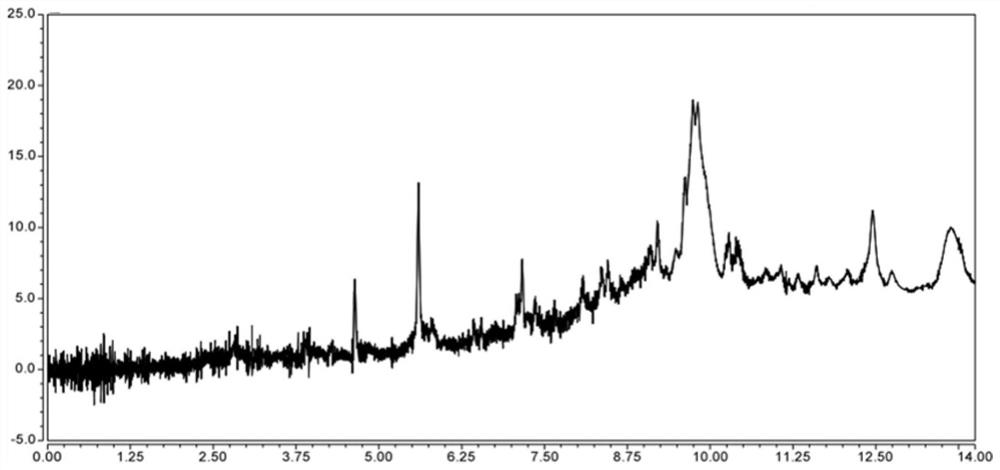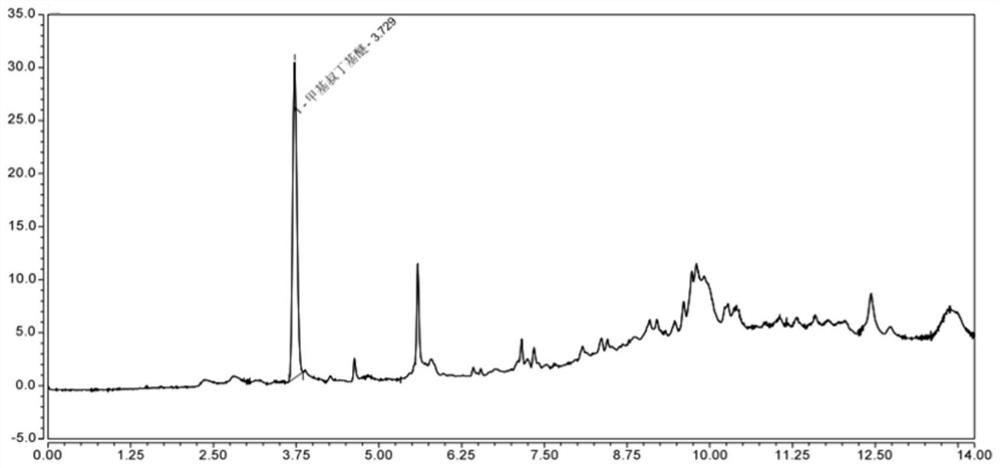Method for detecting residual solvent in antiangitide by utilizing gas chromatographic method and application
A gas chromatography and residual solvent technology, applied in the field of drug detection, can solve problems such as solvent residues, affecting the safety of the final product, and achieve the effects of stable quality, great practical significance and academic value, and strong specificity.
- Summary
- Abstract
- Description
- Claims
- Application Information
AI Technical Summary
Problems solved by technology
Method used
Image
Examples
Embodiment 1
[0039] This embodiment provides a gas chromatography analysis and detection method for residual DMSO in antiangitide, the specific steps are as follows:
[0040] Take the antiangitide sample to be tested, accurately weigh it, add water to dissolve and dilute to make a solution containing about 20 mg of antiangitide in each 1ml, and prepare 2 parts in parallel as the test solution; Take 50 mg of sulfone, dilute it in a 50 mL volumetric flask, adjust the volume to the mark and mix evenly, measure 1 ml, put it in a 10 ml volumetric bottle, add water to dilute to the mark, shake well, and prepare 2 copies in parallel as the control solution.
[0041] Use 6%-cyanopropylphenyl-94% dimethyl polysiloxane capillary column (DB-624, 30m×0.53mm×3μm) as the chromatographic column, the flow rate is 3mL nitrogen per minute, and the gas flow rate is 30ml / min , the flow rate of the assisted gas is 400ml / min. The temperature of the detector is 250°C, the temperature of the injection port is 28...
Embodiment 2 Embodiment 1
[0042] The specificity test of embodiment 2 embodiment 1 method
[0043] (1) Scheme design
[0044] To investigate whether the organic solvents introduced in the production process of antiangitide and the volatile components of the main component interfere with the detection of dimethyl sulfoxide. Test method is the same as embodiment 1.
[0045] Antiangitide production process includes: Wang resin as carrier, Fmoc protected amino acid as raw material, DIC, HOBt as condensation agent and catalyst, DMF, DMSO, DCM as solvent, piperidine / DMF solution as deprotection reagent, anhydrous methanol As a shrinking solvent, solid-phase synthesis was performed to obtain a peptide resin. Cleavage the peptide from the resin with TFA-based lysate, settle the peptide with methyl tert-butyl ether and dry it to obtain the crude peptide. The crude peptide is purified by preparative HPLC with acetonitrile and salt solution as the mobile phase. Refined peptides were obtained by lyophilization....
Embodiment 3
[0068] 1. Quantitation limit and detection limit
[0069] (1) Scheme design
[0070] From the limit concentration control solution, dilute step by step, the concentration when the signal-to-noise ratio is 10:1 is the limit of quantification; the concentration when the signal-to-noise ratio is 3:1 is the limit of detection.
[0071] (2) Experimental method
[0072] Detection limit: take the dimethyl sulfoxide limit concentration solution, dilute it with water step by step to a certain concentration solution, inject samples, and the test method is the same as in Example 1. In the resulting chromatogram, the signal intensity of the main peak and the noise peak should not be less than 3, then the concentration of the solution at this time is the detection limit of the component.
[0073] Quantitative limit: take the limit concentration solution of dimethyl sulfoxide, dilute it into a solution with a certain concentration step by step with water, inject samples, and the test meth...
PUM
| Property | Measurement | Unit |
|---|---|---|
| concentration | aaaaa | aaaaa |
Abstract
Description
Claims
Application Information
 Login to View More
Login to View More - R&D
- Intellectual Property
- Life Sciences
- Materials
- Tech Scout
- Unparalleled Data Quality
- Higher Quality Content
- 60% Fewer Hallucinations
Browse by: Latest US Patents, China's latest patents, Technical Efficacy Thesaurus, Application Domain, Technology Topic, Popular Technical Reports.
© 2025 PatSnap. All rights reserved.Legal|Privacy policy|Modern Slavery Act Transparency Statement|Sitemap|About US| Contact US: help@patsnap.com



